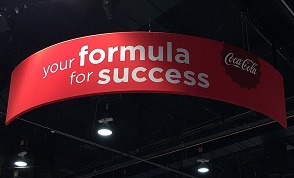
But in a world where those health-focused, customize-everything (and disposable-income wielding) millennials have grown to know soda as a beverage to beware, even the soothing image of a cold, perspiring can of Coke has given way to darting eyes, often seeking a bevy of better-for-you options, with new products continuing to spring up like wildfire. Millennials’ aversion to soft drink consumption has been a key component of a sustained decline in sales of Coke and other soda products.
However, at the recently held National Association of Convenience Stores (NACS) show, it was clear that Coca-Cola had found a way to connect with millennials on a level that spoke to their Instagram-a-pic-of my-pink-socks ways with its highly successful “Share a Coke” campaign.
The marketing program was simple: earlier this year, Coca-Cola labeled select and limited-edition 20 oz. bottles of Coke, Diet Coke and Coke Zero with first names and monikers popular among millennials and young people, and encouraged consumers to share those products with friends and family members. The company asked buyers and recipients of the drinks to post images of the beverages on social media using the hashtag #ShareaCoke.

In a presentation about the effectiveness of Share a Coke, the company pointed to a surge in C-store dollar sales of Coke products, comparing year-over-year numbers for the four-week period ending on July 28, 2014. Coca-Cola noted that the program had a much bigger effect on sales in stores that used promotional signage and displays of the Share a Coke Campaign.
Coca-Cola’s praise of the program has been equaled by that of Wall Street analysts, including Wells Fargo Securities analyst Bonnie Herzog, who in a recent report on C-stores sales data provided by Nielsen compared year-over-year numbers for the four-week period ending on September 27. Herzog noted that amid an overall 1.6 percent jump in dollar sales of CSDs, dollar sales of Coke products were up 4.3 percent (+ 4.9 percent over a 12 week period), pointing to Coke’s ability to gain value and volume share as compared to its competitors, something that she attributes “to its successful Share a Coke campaign, and best-in-class price/pack architecture.”
Coca-Cola is hoping to build upon the success of Share a Coke, when the company reintroduces the campaign in April 2015. Dubbed Share a Coke 2.0 (undoubtedly a name for corporate documents/presentations), the company will aim to cover 90 percent of millennial names in the second edition, which Coca-Cola is promoting as being “Bigger & Better.” In comparison to the inaugural program, 2.0 will include a range of packages sizes as well as a promotional focus on holidays, including Mother’s Day.
While the company is certainly pleased with the sales boost provided to its Coke products, Coca-Cola nevertheless understands that, in the long-term, consumer trends toward healthier consumption and demand for premium goods will require a sustained investment in innovation and variety of products. And in a recently announced agreement, the company will jointly work with PepsiCo and the Dr Pepper Snapple Group toward a goal of decreasing beverage calorie consumption per American nationally by 20 percent by 2025.

With an eye on a rapidly growing market for protein/meal replacement drinks in the C-store channel, Coca-Cola is leaning on its relationship with fairlife, LLC (which works with Coke’s Venturing and Emerging Brands incubation unit) to increase its presence in the category. Coke introduced a new look for Core Power, fairlife’s line of milk-based protein drinks and also presented a fairlife-branded line of milk products that have been “ultra-filtered.” The process allows for 50 percent more natural protein and 30 percent more calcium than ordinary milk, according to the company.

In a surprise sneak peek, Coca-Cola unveiled a new bottle and label design for Honest Tea’s PET bottles, which is scheduled to roll-out next year. Like its glass bottle and “Refreshers” lines, the brand’s evolved look places greater emphasis on the word “Honest.” The labels now feature the phase “just a tad sweet” and the word “organic” in cursive, something that Coke believes reinforces the key differentiators between the brand and its competitors.
As for other new products showcased by the cola giant:
- FUZE Berry Punch, which is the brand’s most popular 1L variety, will now come in a 20 oz. bottle as well.
- Next year, two new flavors – Berry Blend and Tropical Blend – will be added to the Minute Maid Premium Blend Juice Drinks line. Berry Blend contains orange, grape, raspberry and strawberry flavors while Tropical Blend has orange, pineapple, tangerine, passion fruit and lemon.
- Beginning in January, Coke’s Simply juice brand will feature two new flavors — Fruit Punch and Tropical — as part of its 11.5 oz. bottle line.
- A new limited edition lemonade flavor is coming for Powerade. Packaged in a 32 oz. bottle, the beverage will launch in April in convenience retail, drug and value stores.
- As a result of the NBA superstar’s leap to his original team and jersey number, Sprite has renamed its 6 Mix by LeBron James to Sprite LeBron’s Mix. The cherry and orange flavored soda will be available in C-stores from March to June as sold in 20 oz. PET bottles and as a frozen carbonated beverage.
